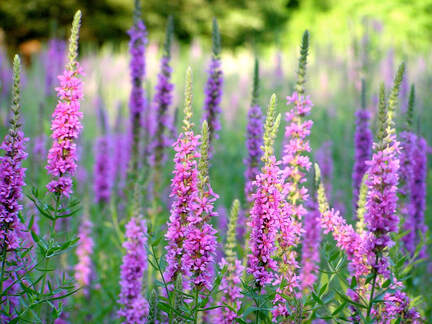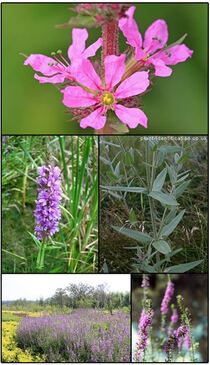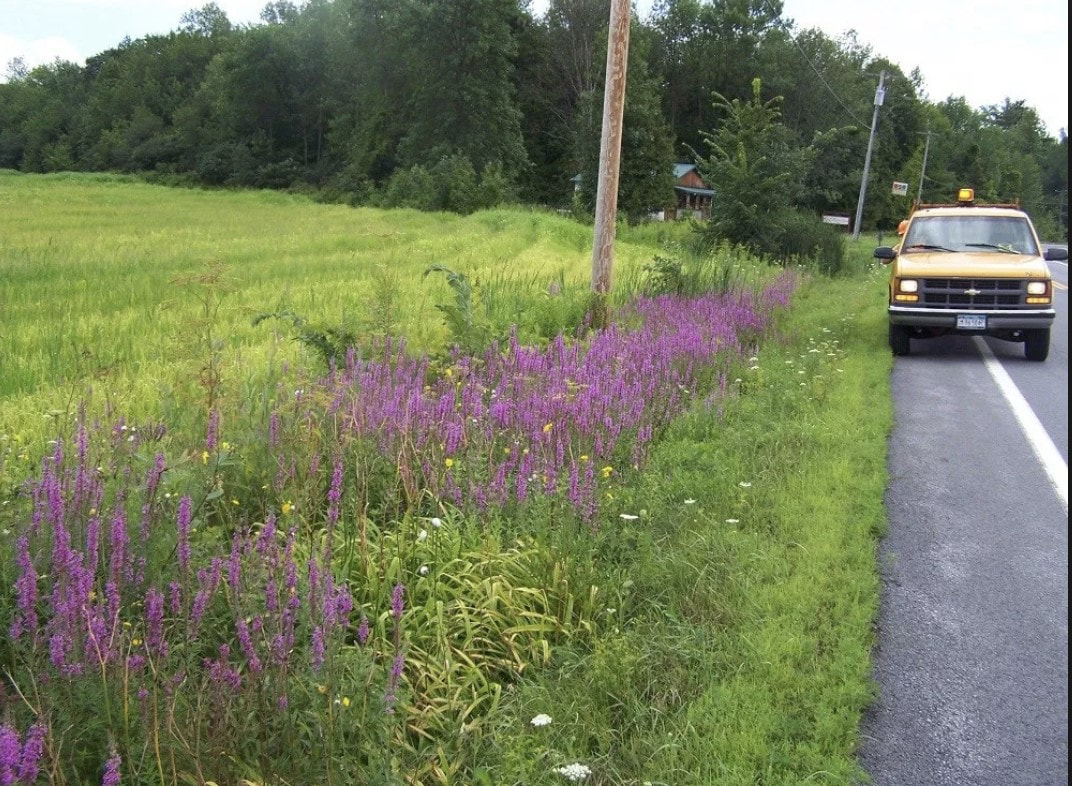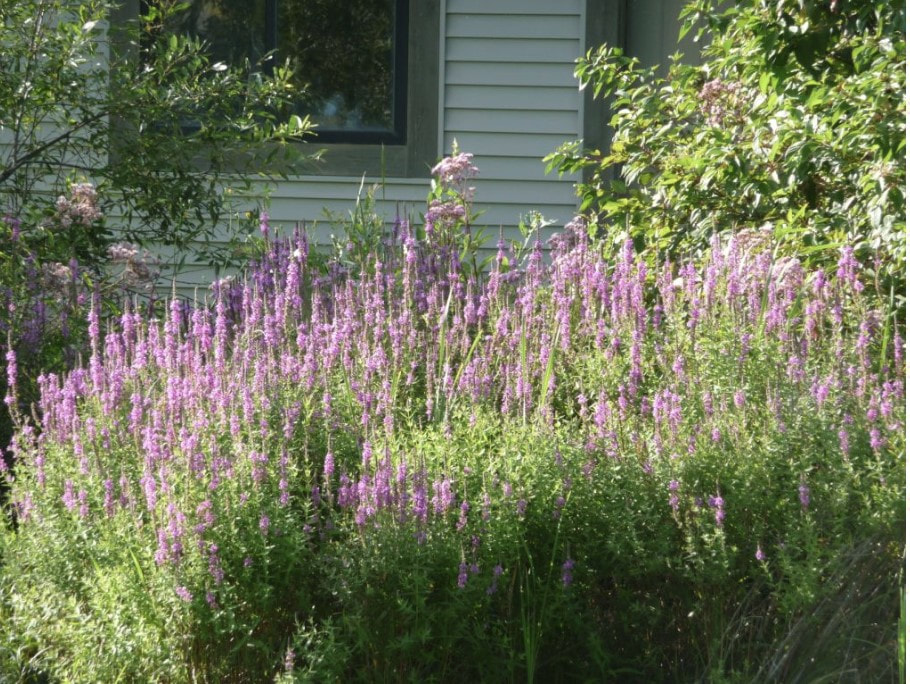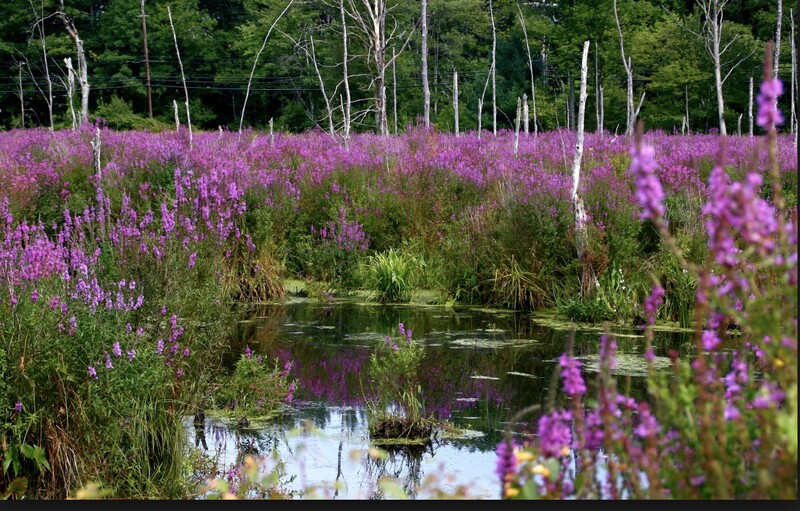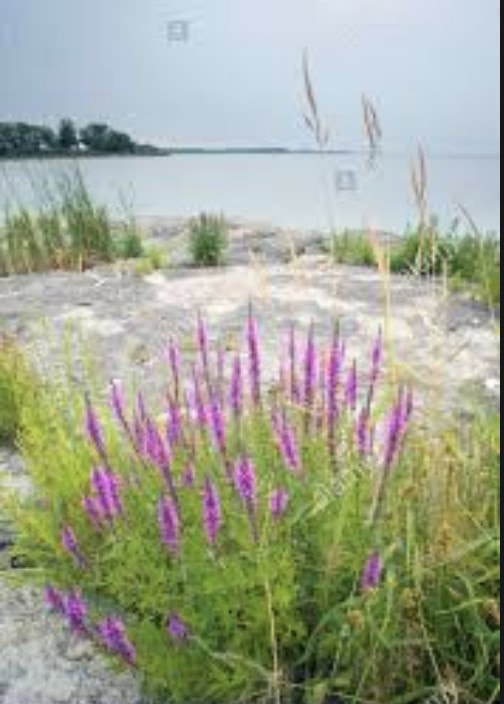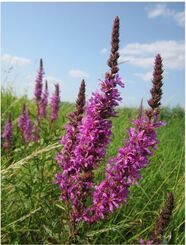
Pretty Problems: Purple Loosestrife
By Erica Sprague, Meridian Junior High Schools
CLICK ON IMAGE TO DOWNLOAD A PRINTABLE VERSION OF THIS LESSON PLAN
We would greatly appreciate your feedback! Click here to complete a short survey telling us about your experience with this lesson plan.
By Erica Sprague, Meridian Junior High Schools
CLICK ON IMAGE TO DOWNLOAD A PRINTABLE VERSION OF THIS LESSON PLAN
We would greatly appreciate your feedback! Click here to complete a short survey telling us about your experience with this lesson plan.
Target Grades: Middle School Science (6-8) or High School Science (9-12)
Lesson Overview
Purple Loosestrife has long been identified as an invasive plant species in Michigan and has had great success in being controlled in many locations, but there is still an abundance “on the loose”. Students will learn more about why the purple loosestrife is invasive and its effect on local ecosystems. Then, they will research the best methods for controlling purple loosestrife in a specific, described location. This project may also be extended and used as a service project over the summer during June, July and August when purple loosestrife is best controlled.
Time: 3-4 Class Periods (60 minutes each) depending on depth of presentation
Guiding question: What are invasive plants and how can they be controlled?
Sources Consulted
Learning Objectives
After the lesson, students will be able to:
Michigan Science Standards Addressed
SEP: Science and Engineering Practices
List of Materials
Room Arrangement or Special Needs
Students are grouped together for the activities (3-4 students/group max).
New Vocabulary
5E Model Lesson Plan
Engage
Lesson Level Question: What is the best way to control purple loosestrife in a variety of locations?
Purple loosestrife has long been known as an invasive plant species in Michigan. To engage students, show photos of fields covered with these pretty plants and discuss why people might have been planted them on purpose in the past (however, they are now restricted in Michigan and cannot be offered for sale) and why they might be considered a problem today.
Lesson Overview
Purple Loosestrife has long been identified as an invasive plant species in Michigan and has had great success in being controlled in many locations, but there is still an abundance “on the loose”. Students will learn more about why the purple loosestrife is invasive and its effect on local ecosystems. Then, they will research the best methods for controlling purple loosestrife in a specific, described location. This project may also be extended and used as a service project over the summer during June, July and August when purple loosestrife is best controlled.
Time: 3-4 Class Periods (60 minutes each) depending on depth of presentation
Guiding question: What are invasive plants and how can they be controlled?
Sources Consulted
- Success Story: Controlling PL
- Ontario Invading Species Awareness
- Control Methods (Minnesota)
- Management Methods (USDA)
- Improper Methods
Learning Objectives
After the lesson, students will be able to:
- Explain why purple loosestrife is an invasive species
- Describe methods for controlling purple loosestrife, including those that are most beneficial and those that can be harmful
- Determine the best method of removal of purple loosestrife given a very specific scenario where purple loosestrife has invaded
- Apply the best method of removal to an area in the community with permission and partnerships with local agencies (if possible and organized ahead of time by the teacher)
Michigan Science Standards Addressed
SEP: Science and Engineering Practices
- Asking questions and defining problems
- Analyzing and Interpreting Data
- Planning and Carrying Out Investigations
- MS-LS2-1 Analyze and interpret data to provide evidence for the effects of resource availability on organisms and populations of organisms in an ecosystem.
- MS-LS2-3 Develop a model to describe the cycling of matter and flow of energy among living and nonliving parts of an ecosystem.
- MS-LS2-4 Construct an argument supported by empirical evidence that changes to physical or biological components of an ecosystem affect populations.
- Cause and Effect
- Stability and Change
List of Materials
- Computer access to links or printed articles.
- If teachers are able to connect with community members to create a service project, there may be additional materials needed to go out into the field and remove purple loosestrife
Room Arrangement or Special Needs
Students are grouped together for the activities (3-4 students/group max).
New Vocabulary
- Invasive Species: A non-native species in an ecosystem that may cause harm to the economy, the environment or human health.
- Biocontrol or biological control: the use of living organisms, such as insects, pathogens, or grazing animals, to reduce the population of a pest.
- Herbicide: a substance that is toxic to plants, used to destroy unwanted vegetation.
5E Model Lesson Plan
Engage
Lesson Level Question: What is the best way to control purple loosestrife in a variety of locations?
Purple loosestrife has long been known as an invasive plant species in Michigan. To engage students, show photos of fields covered with these pretty plants and discuss why people might have been planted them on purpose in the past (however, they are now restricted in Michigan and cannot be offered for sale) and why they might be considered a problem today.
Photo on left is from Wikimedia Commons, by Liz West. Photos on right are from the MISIN website.
This lesson will explore what is purple loosestrife and how can these invasive plants be controlled or eliminated. There are many methods of removing it and a lot of success in controlling it. Students could discuss pulling it out of the ground, treating with chemicals (herbicides), and biological control. Some methods of removal can make things worse! After doing their research students can explain how that could be.
Then students will be given a “purple loosestrife” problem scenario to solve: Their job is going to be to analyze a situation where purple loosestrife has invaded and research the best possible way to curb and control the loosestrife. If possible, this project could become a service project in conjunction with local entities to help in your community where loosestrife is a problem.
Explore - Activities
Explain - Determining Methods of Control
Elaborate
Evaluate - Apply Knowledge
Four purple loosestrife scenarios
Assign one scenario per group. If there are more than 4 groups, some groups may have the same scenario as another group, but they should not work together. At the time of their presentations they can compare their solutions.
Then students will be given a “purple loosestrife” problem scenario to solve: Their job is going to be to analyze a situation where purple loosestrife has invaded and research the best possible way to curb and control the loosestrife. If possible, this project could become a service project in conjunction with local entities to help in your community where loosestrife is a problem.
Explore - Activities
- What is purple loosestrife? Why is it invasive? Teachers can lead a discussion to see what students already know or use this Know/Need to Know information collection strategy:
- Give each student 2 sticky notes.
- Write one thing you know about purple loosestrife
- Write one thing you want to know or need to know about purple loosestrife
- Have all students put their note on a class paper or whiteboard where all sticky notes can be analyzed or grouped together (repeats, similar responses).
- Reading Option 1: Prevent invasives from harming Michigan’s native species (Detroit Free Press) Will help students understand what invasive species are, some common invasive species in Michigan, including the purple loosestrife and its success story!
- Reading Option 2: Success Story: Controlling PL (Michigan NPR Radio) Focuses on the success of controlling PL in Michigan.
- Video Option: Invaders in Our Waters: Purple Loosestrife
Explain - Determining Methods of Control
- Students will use web resources to learn more about the methods used to control PL. There are many methods, but students will have to determine the best for their unique scenario later in the lesson. There are some methods that are BAD and students should research those as well and why the method can do more harm than good. Groups will share out later in the lesson.
- Resources for research:
Elaborate
- Students will be assigned to groups to come up with solutions to one of four different purple loosestrife invasion scenarios (click on the link or see the end of this page). They will then have an opportunity to present their solution to their unique scenario in a presentation method determined by the teacher.
- Display board
- Slide Show
- Science Fair Presentation
- Infographic
- Class discussion about different methods (including improper methods) used and where these methods could be used in our community. Some possible problems that students might bring up are how to avoid the spread of seeds, effects of herbicides on native plants and people, and how to make sure there that the beetles that are sometimes used in biocontrol do not themselves cause problems.
Evaluate - Apply Knowledge
- Remind students of the lesson level guiding question and assign each group a scenario. Students will be evaluated on the quality of their solution and their reasoning for choosing the best method of control, as well as methods that should not be used.
Four purple loosestrife scenarios
Assign one scenario per group. If there are more than 4 groups, some groups may have the same scenario as another group, but they should not work together. At the time of their presentations they can compare their solutions.
Scenario #1: Purple Loosestrife (PL) has taken over a ditch. It is approximately 12 feet wide and extends about 300 feet along the roadside. The road commission does not want it to spread to the ditches down the road.
Scenario #2: Someone has planted a small area of PL in their garden. What you see is the only area PL has spread. The homeowner did not realize it was invasive and needs it to be removed.
Scenario #3: This swamp is beautiful to look at, but the PL is taking over this swamp. It is very established and is choking out the native plants and animals. How can PL be taken care of here?
Scenario #4: Park rangers have noticed clumps of PL popping up in beach areas along the lake at a state park. The beach is a popular place to visit and PL is quickly taking over.
Scenario #2: Someone has planted a small area of PL in their garden. What you see is the only area PL has spread. The homeowner did not realize it was invasive and needs it to be removed.
Scenario #3: This swamp is beautiful to look at, but the PL is taking over this swamp. It is very established and is choking out the native plants and animals. How can PL be taken care of here?
Scenario #4: Park rangers have noticed clumps of PL popping up in beach areas along the lake at a state park. The beach is a popular place to visit and PL is quickly taking over.

New lesson plan ideas are welcome and will be uploaded as they are received and approved.
Instructions for submitting lesson plans for:
About invasive species,
About science and science careers
For information about submitting new lesson plans, please contact jchadde(at)mtu.edu
Lesson plan ideas from other web sites:
From Pennsylvania Sea Grant: 10 lesson plans about interactions of invasive species, biodiversity, and climate change
Creation of the above page of educational resources was funded in part by the Michigan Invasive Species Grant Program through the Departments of Natural Resources, Environmental Quality, and Agricultural and Rural Development.
This material is also based upon work supported by the National Science Foundation under Grant No. 1614187.
Any opinions, findings, and conclusions or recommendations expressed in this material are those of the authors and do not necessarily reflect the views of the National Science Foundation.
Instructions for submitting lesson plans for:
About invasive species,
About science and science careers
For information about submitting new lesson plans, please contact jchadde(at)mtu.edu
Lesson plan ideas from other web sites:
From Pennsylvania Sea Grant: 10 lesson plans about interactions of invasive species, biodiversity, and climate change
Creation of the above page of educational resources was funded in part by the Michigan Invasive Species Grant Program through the Departments of Natural Resources, Environmental Quality, and Agricultural and Rural Development.
This material is also based upon work supported by the National Science Foundation under Grant No. 1614187.
Any opinions, findings, and conclusions or recommendations expressed in this material are those of the authors and do not necessarily reflect the views of the National Science Foundation.
